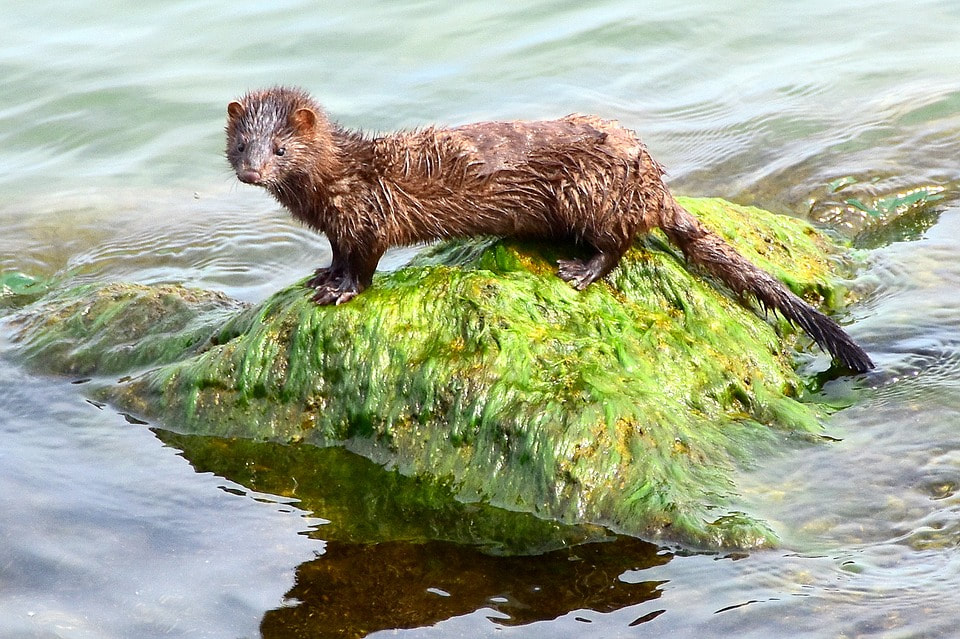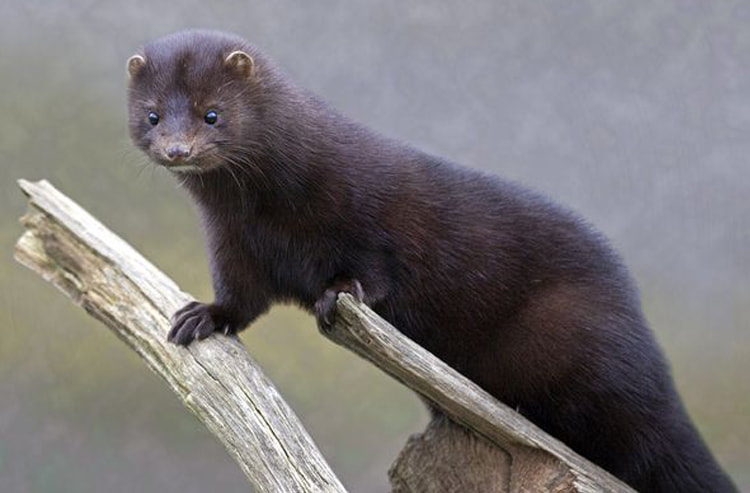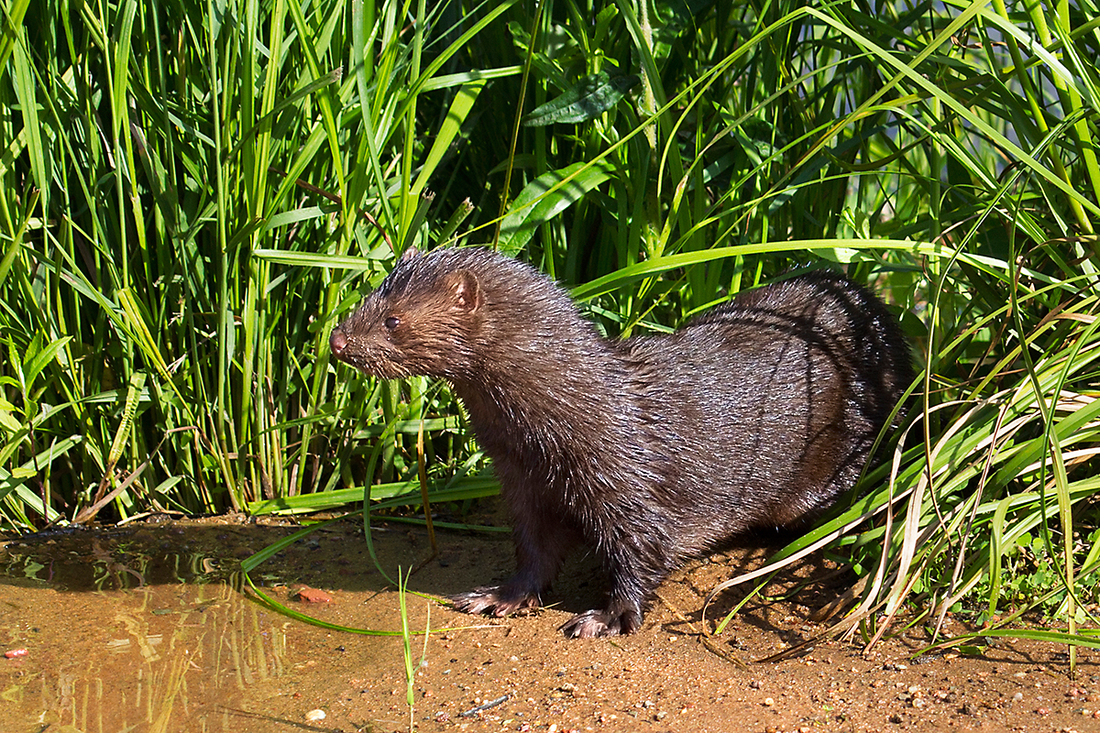Understand The Nature of the Animal.
Minks are not your everyday pet friendly animal. These are a sassy no nonsense animals and are skilled hunters and fast on the kill. Minks do not like to be cornered and will react in a very aggressive nature if so be the case. You can tame a Mink to act less aggressive if that mink has been domesticated from birth.
Minks are semi-aquatic. This means that they spend time on land and in water. They do not live permanently in a single spot. Instead, they transfer from one shelter to another frequently. Minks have numerous adaptations. Their physical attributes correspond to their respective adjustments to the surroundings. Walking with their four legs, minks can paddle on waters, mimic and hide in swamp areas. Their camouflage capacity tends them to thrive longer than any animals in forest areas of South Dakota and other states in the United States.
What Do Minks Eat?
Minks are carnivorous. They will eat anything that moves on land and in water they can manage. Minks will feast on fishes, rabbits, rats, some snakes, lizards, frogs, shrews, muskrats, birds. They will eat any bird they can catch and this also includes chicken.
How Long Do Minks Live?
The mink lifespan just as any kind of mammal depends on where the animal lives and how it is fed. The maximum lifespan of a domesticated mink is usually around ten years, but rarely exceed three years in the wild.
Gestation Period For Minks.
The minks breeding season is basically a one month period as it begins at the end of February and ends in March. Although the true gestation period is 39 days, the embryo may stop developing for a variable period, so that as long as 76 days may elapse before the litter arrives. Between 45 and 52 days is normal. There is only one litter per year. They may have between six and 10 kits per litter.
The sad truth about captivated minks or minks basically bred into domesticated environment is for fur. Yes, most mink breeder don't breed minks because there is a great demand for mink as a pet. They breed them because there is an expensive demand for the mink coat. Fur farming does not have the best interest of the mink at heart. Normally minks bred for it's coat will lack some of the basic environmental needs of the mink such as water. These domesticated or captivated minks are kept stacked in cages and fed until they are at a suitable age for the coats to be removed.
Buying A Mink As a Pet
I personally would not recommend anyone having a mink as a pet. But for those who are fascinated by exotic animals and are hell bent on having a domesticated mink reside in your dwelling, you must then me up to the full task of taking proper care of the mink. Minks are not your eat and go sleep kind of animal. The mink requires a lot of activity and thus mink pet owners must be up to this task at all times. Behaviors such as cage pacing. (anxiety or stressful behavior in animals where the animals walks to and from in it's cage continuously. Sometimes in circles.) This normally happens when the needs of the Mink is seldom met. The mink is a natural hunter and carnivore. No matter how domesticated they tell you a mink is. Just let that animal out the cage and I grantee it will be looking around for it's next live meal.
Pool For Mink
Mink pet owners must ensure that the animal has access to plenty of water as minks are semi-Aquatic and will need water to rest in and cool down also.
As a Mink pet owner, you must be aware of any kind of disease the animal may likely to carry or contract. Aleutian disease (AD) was first described in farm-raised mink in 1956. The disease was so named because it was first found in mink with the Aleutian coat colour gene. It has since been demonstrated that all colour phases of mink are susceptible to the disease, however, marked differences in the average severity of the disease have been noted. The disease is recognized throughout the world and is presently the most important infectious disease affecting farm-raised mink.
- Cause
Aleutian disease is caused by a virus belonging to the family Parvoviridae.
- Transmission
The virus is present in the blood, bone marrow, spleen, feces, urine and saliva of infected mink. The disease can be transmitted to healthy mink directly by contact with infected mink or indirectly by contamination of feed, water, equipment or clothing with the feces, urine or saliva of infected mink. Since the virus is present in the blood of infected mink, fleas are likely capable of transmitting the virus to other animals. An important means of transmission of the infection is from the female to her kits.
Vet Service For Your Pet Mink. Mink Vaccination.
Yes, there are vets who will look at your mink. Vets are skilled in arfeas of caring for wild animals such as a pet mink. However, all minks which are deemed domesticated are required to have the animal vaccinated. Mink kits are vaccinated when at least 6–8 wk old with a 3-way vaccine containing Pseudomonas bacterin, botulism, and mink enteritis virus, and again when at least 10 wk old with a modified-live distemper vaccine. Breeders should be revaccinated in December or January before the breeding season.
Your mink will live with you. But where should you place your mink? Well you must get a cage which is suitable for the animal. Minks are busy body animals and a tiny cage does not work well for the animals interaction. Get a mink cage that is large and has upper levels and lower levels. Ensure that the cage has a easy compartment where the mink feces and simply be pulled out and disposed of. Have an area in that cage which can hold a basin firmly in place so the mink can have a dip now and then without the container being turned over. Let your pet mink living conditions be a near match to what it would be if the animal was free.
How a domesticated mink interacts with you have a lot of variations. It will depend on the individuals animal character and age. Minks which have been domesticated by the owner at birth tend to often be less aggressive and have a greater bond with it's owner. But these are minks and they are not pet dogs are cats. Never let anyone else try to pet your mink no matter how domesticated you think the animal is. They may end up with a bloody finger or scratches to the face. Minks are not pet for children and should never be given to one. Minks are for those pet owners who like the risk and wittiness which comes with having exotic animals as pets.




 RSS Feed
RSS Feed
